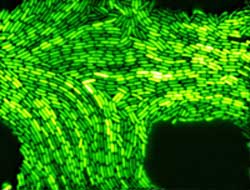Study suggests ’noise’ in gene expression could aid bacterial pathogenicity

A high level of variation in the amount of green fluorescence protein in individual non-growing E. coli cells surprised synthetic biology researchers at Boston University and the University of California, San Diego
Synthetic biology experiment turns up a previously unrecognized gene-expression phenomenon
An experiment designed to show how a usually innocuous bacterium regulates the expression of an unnecessary gene for green color has turned up a previously unrecognized phenomenon that could partially explain a feature of bacterial pathogenicity.
In a paper published in the Feb. 16 issue of Nature, researchers at Boston University (BU) and the University of California, San Diego (UCSD) reported that computer modeling predicted the new phenomenon before they confirmed it in laboratory experiments. The group led by James J. Collins, a biomedical engineering professor at BU, and Jeff Hasty, a bioengineering professor at UCSD, reported that the rise and fall in the amount of green-fluorescence protein in computer modeling matched the pattern recorded in E. coli cells grown in various laboratory conditions.
The researchers were surprised that cell-to-cell variation in the expression of the synthetic gene increased sharply as growth slowed and then stopped. “We were initially skeptical of our own results because they were so counterintuitive,” said Collins. “But our laboratory experiments confirmed this increase in gene-expression variability, or noise, when growth stops. We think there may be some very interesting biology to explore in this situation.”
Variability in gene expression could offer distinct survival advantages to a bacterium. Like a cruise ship whose life boats have been stocked with different combinations of food, first-aid kits, rain jackets, and flotation devices, a microscopic version of Survivor could occur in which only those individual bacterial cells with opportune combinations of proteins are able to weather harsh growth conditions in a pond or even inside a human body.
“This phenomenon could be relevant to bacterial ’persisters’ – dormant cells that are highly resistant to antibiotics,” said Collins. “Many bacterial pathogens can generate these persisters, which over many months can become the source of chronic infections. We don’t understand the how persisters arise, but we think this unexpected gene-expression variability in bacterial cells is an interesting phenomenon that should be explored.”
The group of researchers came up with the novel finding by using a relatively new research approach that involves the synthesis of simple gene networks, in this case one that produces a green-fluorescence protein. They measured expression of green fluorescence in a laboratory strain of E. coli under different growth conditions where other genes and proteins could potentially complicate the situation. They incorporated that information into a mathematical model.
The authors say their findings demonstrate the value of a so-called “bottom-up” approach to synthetic biology: models of relatively simple cellular processes can be used to predict the behavior of larger, more complex ones.
“We’re excited by this study because the model itself led to a counterintuitive prediction that was supported by experimentation,” said UCSD’s Hasty. “The logical next step is to examine noise in the expression of proteins that would be essential to a bacterium’s survival,” Hasty said. “We’ve only begun to get an inkling of how noise in gene expression may be involved in the life of a cell.”
Media Contact
More Information:
http://www.ucsd.eduAll latest news from the category: Life Sciences and Chemistry
Articles and reports from the Life Sciences and chemistry area deal with applied and basic research into modern biology, chemistry and human medicine.
Valuable information can be found on a range of life sciences fields including bacteriology, biochemistry, bionics, bioinformatics, biophysics, biotechnology, genetics, geobotany, human biology, marine biology, microbiology, molecular biology, cellular biology, zoology, bioinorganic chemistry, microchemistry and environmental chemistry.
Newest articles

Bringing bio-inspired robots to life
Nebraska researcher Eric Markvicka gets NSF CAREER Award to pursue manufacture of novel materials for soft robotics and stretchable electronics. Engineers are increasingly eager to develop robots that mimic the…

Bella moths use poison to attract mates
Scientists are closer to finding out how. Pyrrolizidine alkaloids are as bitter and toxic as they are hard to pronounce. They’re produced by several different types of plants and are…

AI tool creates ‘synthetic’ images of cells
…for enhanced microscopy analysis. Observing individual cells through microscopes can reveal a range of important cell biological phenomena that frequently play a role in human diseases, but the process of…





















